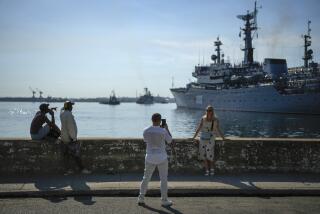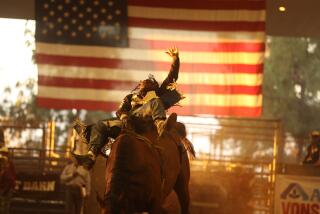Soviets Get a Full Final Sampling of Americana : Diplomacy: On their last day in the Southland, the sailors took in the rodeo at Camp Pendleton, talked to the Boy Scouts and went shopping.
- Share via
Soviet sailors enjoying their last day in San Diego got a full dose of Americana Friday, bartering with Boy Scouts and U.S. Marines while watching a rodeo at Camp Pendleton.
The sailors, who leave for their home port of Vladivostok this morning, spent their last full day here watching the show, trading parts of their uniforms and taking pictures with U.S. servicemen.
Earlier in the day, they saw a flight demonstration at Miramar Naval Air Station and shopped at the commissary.
The Soviets, in the United States as the third in a series of reciprocal U.S.-U.S.S.R. naval visits, said they were surprised by how quickly the week went by and that they had just begun to understand how much there is to see in California.
Sergei Kokolov, a seaman on the destroyer Boyevoy, said through an interpreter that he had seen a rodeo on television in Moscow but that he did not entirely understand what the point is. “I understand it’s a sport,” said Kokolov, 20.
One of the biggest differences between Americans and his countrymen, he said, is that “the people here are so talkative.”
Americans will chat about anything, he said. He also found them unreservedly friendly.
“Everybody who drove by on the road waved,” he said.
While wild horses were kicking inside their pens, a U.S. Marine Corps honor guard paraded to the center of the rodeo grounds, hoisting the Soviet and U.S. flags. Servicemen from both countries saluted as each national anthem was played. In the stands, those in the all-white uniforms of the visitors were interspersed with the hosts in their camouflage fatigues.
But many, rather than watch, hung around the fringes of the arena, exchanging gifts with the Marines and a group of Boy Scouts who had been invited to attend the closed event.
What Americans wanted more than any other item was a T-shirt signed by one of the Soviet sailors; finding someone to explain what they had written was even tougher. Some wrote that they looked forward to seeing the sailors who plan to visit Vladivostok; others simply signed their names.
And the Soviets found themselves puzzled by more than the meaning of rodeo.
The Americans’ frequent use of hand motions prompted many Soviet inquiries to the interpreters, said one, Gunnery Sgt. Kris Hankinson.
On the base, many were perplexed by the Marines’ use of the hand signal that means “I have a phone call for you”--the thumb and pinky extended and the three other fingers curled to the palm.
In the Soviet Union, it is customary for three people to share a bottle of vodka, said Hankinson, and there, the “phone call” motion means “I want to drink vodka, and I need two others to join me.”
“They were wondering what was going on with all these officers,” Hankinson said. “They were beginning to think they were all out looking to find people to drink vodka with.”
Asked about his evaluation of San Diego food and San Diego women, Yevgeniy Finko, 21, said, “The food was good, and so was everything else.”
Finko, a seaman on the Boyevoy from the city of Frunze in the Soviet state of Kirghiz, added that the opinions and attitudes about the United States formed as he was growing up were quickly discarded during his visit.
“It’s pretty much been a total turnaround,” he said.
But overall, when asked what they liked the most about their visit, the Soviets said they had liked many things and had not had enough chance to see them fully.
“It was too little time,” said Zgena Fomenko, 20, a seaman on the destroyer Admiral Vinogradov who hails from a small village on the Volga River. “We didn’t have enough time to see all that there is to enjoy.”
More to Read
Sign up for Essential California
The most important California stories and recommendations in your inbox every morning.
You may occasionally receive promotional content from the Los Angeles Times.










